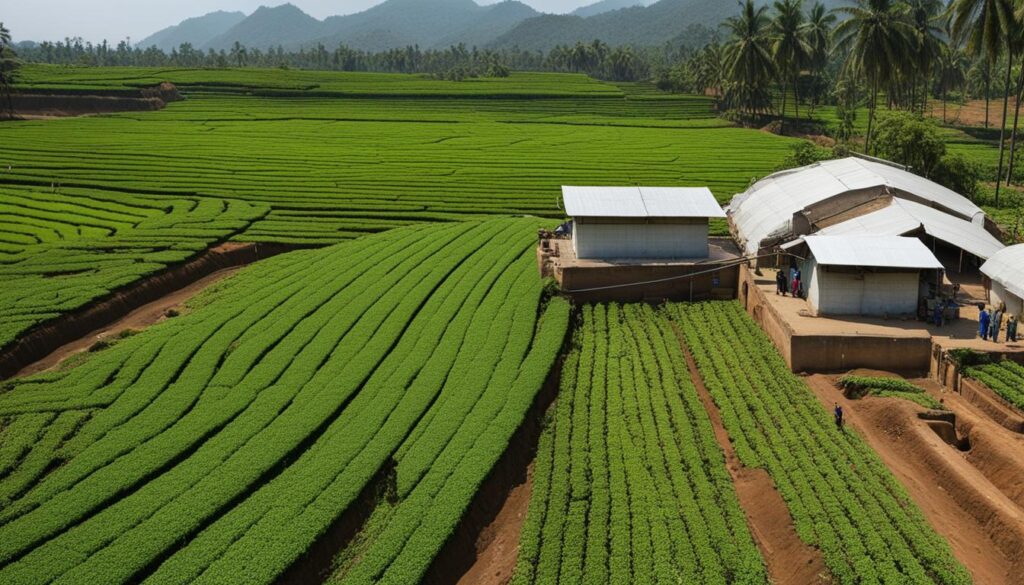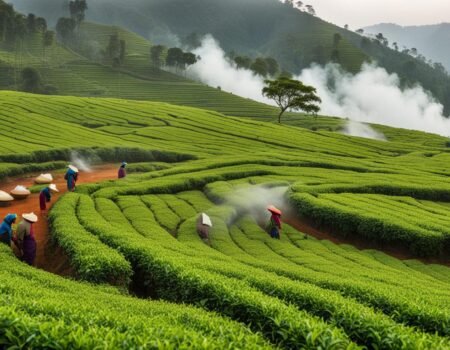
Irrigation Systems for Tea Cultivation: Design and Implementation
Irrigation plays a crucial role in maximizing the yield and quality of tea cultivation. Proper design and implementation of irrigation systems can ensure efficient water use and optimal soil moisture management in tea gardens, leading to increased yield and improved quality of tea production.
In a study conducted in Southern Tanzania, drip irrigation systems for tea farms have been found to significantly increase yield and water productivity. Different clones of tea plants were subjected to six different drip irrigation treatments, and it was found that specific clones had the highest yields when treated with drip irrigation. Drip irrigation also resulted in water saving benefits of up to 50% compared to overhead sprinkler systems, while maintaining or improving tea plant health.
Choosing the appropriate irrigation system and implementing efficient irrigation practices are key steps towards achieving successful tea cultivation. Let us dive deeper into the impact of irrigation on tea quality, efficient and sustainable irrigation practices, designing an effective irrigation schedule, choosing the right irrigation system, and managing soil moisture in tea gardens.
Key Takeaways:
- Irrigation is essential for maximizing tea yield and quality.
- Drip irrigation systems increase yield and water productivity, while saving water.
- Irrigation practices can impact tea quality, requiring proper techniques.
- Efficient and sustainable irrigation practices are crucial for water conservation.
- An effective irrigation schedule considers factors like soil type, climate, and plant water requirements.
The Impact of Irrigation on Tea Quality
Proper irrigation practices play a crucial role in determining the quality of tea. A cost analysis of tea farm irrigation has revealed that drip irrigation systems can be more cost-effective compared to other irrigation methods. These systems provide precise water delivery directly to the root zone of the plants, minimizing water loss through evaporation and ensuring efficient water use. The controlled application of water through drip irrigation can result in consistent moisture levels in the soil, which is essential for the development of desirable compounds in tea leaves, leading to enhanced flavor, aroma, and color.
However, it is important to note that irrigation can also have a negative impact on tea quality if not properly managed. Excessive irrigation or inadequate drainage can cause leaching of nutrients and lead to the degradation of tea quality. Therefore, it is crucial to choose the appropriate irrigation technology and implement sustainable irrigation practices to maintain the highest quality of tea.
“Proper irrigation practices can have a significant impact on tea quality. Consistent moisture levels in the soil promote the development of desirable compounds in tea leaves, resulting in better flavor, aroma, and color.”
In conclusion, the impact of irrigation on tea quality cannot be underestimated. By utilizing cost-effective irrigation systems such as drip irrigation and implementing sustainable irrigation practices, tea farmers can ensure optimal water distribution, minimize water loss, and enhance the quality of their tea crops. Managing irrigation carefully is essential to strike a balance between providing enough water for tea plant growth and avoiding the negative consequences of excessive irrigation on tea quality. With the right irrigation technology and practices in place, tea farmers can achieve remarkable results in terms of yield and overall tea quality.

Efficient and Sustainable Irrigation Practices
As tea cultivation continues to thrive, it becomes increasingly important to adopt efficient and sustainable irrigation practices. We understand that water resources are limited and need to be managed wisely in order to ensure the long-term success of tea gardens. By implementing the right irrigation techniques, tea farmers can optimize water use efficiency while minimizing the environmental impact.
One key practice for improving water use efficiency in tea gardens is irrigation scheduling. By basing irrigation on plant water requirements and closely monitoring soil moisture levels, farmers can ensure that water is only applied when necessary. This not only reduces water waste but also promotes optimal plant health and growth. Implementing techniques such as alternate wetting and drying and controlled irrigation can further enhance water use efficiency in tea farms.
In addition to irrigation scheduling, sustainable irrigation practices also involve making smart choices when it comes to irrigation systems. Drip irrigation, for example, delivers water directly to the root zone of the plants, minimizing evaporation and maximizing water use efficiency. This system is particularly beneficial for tea farms with limited water availability. On the other hand, overhead irrigation systems, such as sprinkler systems, may cover larger areas but can result in more water loss through evaporation. The choice of irrigation system depends on factors such as farm size, water availability, and the desired level of control over water distribution.
By adopting efficient and sustainable irrigation practices, tea farmers can not only conserve water but also contribute to overall environmental sustainability in the tea industry. As we strive to achieve both economic success and environmental stewardship, it is crucial that tea gardens are managed in a way that balances the needs of the crop with the need to conserve water resources. Through careful planning, smart technology choices, and ongoing monitoring, tea farmers can ensure the continued success of their operations while minimizing their impact on the environment.
Table: Comparative Analysis of Irrigation Techniques in Tea Cultivation
| Irrigation Technique | Advantages | Disadvantages |
|---|---|---|
| Drip Irrigation | – Precise water delivery to root zone – Reduces water waste through evaporation – Improves water use efficiency | – Initial setup cost – Requires regular maintenance |
| Overhead Irrigation | – Covers larger areas – Suitable for farms with abundant water sources | – Higher water loss through evaporation – Less precise water distribution |
| Alternate Wetting and Drying | – Reduces water use – Promotes root growth and nutrient uptake | – Requires careful monitoring and management |
| Controlled Irrigation | – Provides controlled water application – Minimizes water waste and runoff | – Requires advanced irrigation systems – More complex to manage |
Table: Comparative analysis of irrigation techniques commonly used in tea cultivation.
Designing an Effective Irrigation Schedule
When it comes to tea cultivation, designing an effective irrigation schedule is key to ensuring optimal water supply without wastage. By determining the frequency and volume of irrigation based on various factors, tea farmers can strike a balance between providing enough water for plant needs and avoiding waterlogging or excessive drainage.
The first step in designing an irrigation schedule is to consider the specific requirements of tea plants. Different stages of growth, from active growth to dormancy, necessitate varying water needs. During periods of active growth, tea plants require increased water supply to support their development. However, during dormancy, water requirements decrease. By aligning irrigation with these growth stages, tea farmers can enhance water use efficiency and reduce costs.
To create an effective irrigation schedule, tea farmers must also consider external factors such as soil type, climate, and evapotranspiration rates. Sandy soils, for example, drain more quickly and require more frequent irrigation than clay soils. Likewise, hot and dry climates may necessitate more frequent waterings compared to cooler and more humid regions. By taking into account these factors, tea farmers can tailor their irrigation schedule to the unique needs of their tea gardens.

In addition to the factors mentioned above, tea farmers can also utilize advanced techniques and technologies to optimize their irrigation schedule. Soil moisture sensors, for instance, can provide real-time data on the moisture levels in the soil, allowing farmers to make informed decisions on when and how much to irrigate. By integrating such technologies into their irrigation practices, tea farmers can further enhance water use efficiency and minimize water waste.
Choosing the Right Irrigation System
When it comes to tea cultivation, selecting the appropriate irrigation system is a critical decision that can greatly impact water distribution and conservation. Two commonly used methods are drip irrigation and overhead irrigation. Drip irrigation systems deliver water directly to the root zone of the plants, minimizing evaporation and ensuring efficient water use. This technology is particularly beneficial for tea farms with limited water availability. On the other hand, overhead irrigation systems, such as sprinklers, can cover larger areas but may result in more water loss through evaporation. The choice of irrigation system depends on factors such as farm size, water availability, cost considerations, and the desired level of control over water distribution.
Comparison of Drip Irrigation and Overhead Irrigation:
| Factors | Drip Irrigation | Overhead Irrigation |
|---|---|---|
| Water Distribution | Direct to root zone | Uniform across entire area |
| Water Use Efficiency | High (minimizes evaporation) | Varies (higher risk of evaporation) |
| Water Loss | Minimal | Potential evaporation |
| Cost | Higher initial investment, but potential for long-term savings | Lower initial investment, but potentially higher water usage costs |
| Control | Precise control over water distribution | Less control over water distribution |
Ultimately, tea farmers need to weigh the advantages and disadvantages of each irrigation system to make an informed decision based on their specific needs and resources. Factors such as water availability, farm size, and cost considerations play a crucial role in the selection process. By choosing the right irrigation system, tea farmers can ensure proper water distribution, minimize water loss, and optimize the overall health and productivity of their tea crops.
“Selecting the appropriate irrigation system is like finding the perfect tea blend – it requires careful consideration of the ingredients and brewing technique to achieve the desired taste.” – Tea Expert
Whether it’s drip irrigation or overhead irrigation, the goal remains the same – to provide tea plants with the optimal amount of water while minimizing waste. Both methods have their advantages and disadvantages, and it’s important to evaluate these factors in relation to specific farm requirements. By making an informed decision and implementing the right irrigation technology, tea farmers can ensure the success of their cultivation practices and ultimately produce high-quality tea that satisfies the taste buds of tea enthusiasts around the world.
Managing Soil Moisture in Tea Gardens
Proper soil moisture management is essential for ensuring healthy plant growth and maximizing yield in tea gardens. Tea plants require consistent moisture levels in the soil, but excessive or inadequate moisture can have detrimental effects on plant health and productivity. To effectively manage soil moisture, tea farmers must implement appropriate irrigation techniques, monitoring methods, and mulching practices.
One effective strategy for managing soil moisture is through irrigation scheduling based on the specific water requirements of tea plants. By understanding the water needs of different stages of tea plant growth, farmers can ensure that irrigation is applied at the right times and in the appropriate quantities. This helps to prevent both overwatering and underwatering, ensuring optimal soil moisture levels for tea plants.
Monitoring soil moisture levels is another crucial aspect of soil moisture management. By using soil moisture sensors, farmers can accurately assess the moisture content in the soil and adjust irrigation accordingly. This allows for precise control over soil moisture levels, preventing waterlogging or drought stress in tea gardens.
Effective soil moisture management in tea gardens leads to improved water use efficiency, as it minimizes water wastage and ensures that water is used only when necessary. This not only conserves water resources but also reduces irrigation costs for tea farmers.
Additionally, the use of organic mulch can help maintain soil moisture levels and reduce evaporation. Mulching tea gardens with organic materials such as straw or compost can create a protective layer on the soil surface, preventing moisture loss through evaporation and minimizing weed growth. The mulch also helps to regulate soil temperature and suppresses the growth of harmful pests and diseases.
Table: Comparative Analysis of Soil Moisture Management Techniques
| Technique | Advantages | Disadvantages |
|---|---|---|
| Irrigation Scheduling | – Ensures optimal soil moisture levels – Prevents overwatering and underwatering | – Requires careful monitoring of plant water needs – May require adjustments based on weather conditions |
| Soil Moisture Monitoring | – Provides accurate assessment of soil moisture content – Enables precise control over irrigation | – Requires initial investment in soil moisture sensors – Requires regular maintenance and calibration |
| Organic Mulching | – Maintains soil moisture levels and reduces evaporation – Suppresses weed growth and regulates soil temperature – Improves soil health and fertility | – Requires periodic replenishment of mulch – May attract pests if not properly managed |
In conclusion, managing soil moisture in tea gardens is crucial for optimizing water use efficiency and promoting healthy plant growth. By implementing effective irrigation scheduling, monitoring soil moisture levels, and utilizing organic mulching techniques, tea farmers can ensure optimal soil moisture levels and achieve sustainable tea cultivation practices.
Conclusion
Designing and implementing the right irrigation system is crucial for tea cultivation to maximize yield, conserve water, and enhance tea quality. We have seen that drip irrigation systems have proven to be highly effective in increasing tea yield and water productivity, while also providing cost and labor-saving benefits.
Proper irrigation scheduling, along with sustainable irrigation practices, can further optimize water use efficiency and promote environmental sustainability in the tea industry. By managing soil moisture levels effectively, tea farmers can ensure healthy plant growth and high-quality tea production.
Choosing the appropriate irrigation system and implementing efficient irrigation practices are key steps towards achieving successful tea cultivation. So, let’s make sure we design our irrigation systems carefully, considering factors like farm size, water availability, and desired control over water distribution. By doing so, we can navigate the challenges of tea farming, maximize our tea yield, and ensure a sustainable future for the industry.
FAQ
What is the role of irrigation in tea cultivation?
Irrigation plays a crucial role in maximizing the yield and quality of tea cultivation. It ensures efficient water use and optimal soil moisture management in tea gardens, leading to increased yield and improved quality of tea production.
How does drip irrigation benefit tea farms?
Drip irrigation systems for tea farms have been found to significantly increase yield and water productivity. They also result in water saving benefits of up to 50% compared to overhead sprinkler systems, while maintaining or improving tea plant health.
Which tea plant clones have the highest yields with drip irrigation?
In a study conducted in Southern Tanzania, it was found that the clones TRFCA PC81, BBT207, and BBK35 had the highest yields when treated with drip irrigation.
How can irrigation techniques affect tea quality?
Proper irrigation techniques can have a positive impact on tea quality. Consistent moisture levels in the soil promote the development of desirable compounds in tea leaves, resulting in better flavor, aroma, and color. However, excessive irrigation or inadequate drainage can lead to the leaching of nutrients and degradation of tea quality.
What are some sustainable irrigation practices in tea cultivation?
To improve water use efficiency in tea gardens, recommended practices include irrigation scheduling based on plant water requirements and soil moisture monitoring, alternate wetting and drying, and controlled irrigation. These practices conserve water and contribute to overall environmental sustainability in the tea industry.
How should tea farmers design an effective irrigation schedule?
Tea farmers should determine the frequency and volume of irrigation based on factors such as soil type, climate, tea plant water requirements, and evapotranspiration rates. An irrigation schedule should take into account the stages of tea plant growth, with increased water requirements during periods of active growth and reduced water needs during dormancy.
What are the different irrigation systems used in tea farms?
Common irrigation systems used in tea farms include drip irrigation and overhead irrigation. Drip irrigation delivers water directly to the root zone of the plants, minimizing evaporation and ensuring efficient water use. Overhead irrigation systems, such as sprinkler systems, cover larger areas but may result in more water loss through evaporation.
How can soil moisture be effectively managed in tea gardens?
Effective soil moisture management in tea cultivation involves techniques such as irrigation scheduling, soil moisture monitoring using sensors, and the use of organic mulch to maintain soil moisture levels and reduce evaporation. These practices maximize the efficiency of irrigation systems and promote optimal tea plant health.






